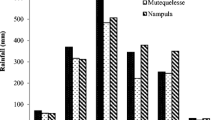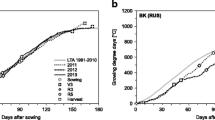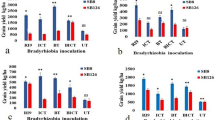Abstract
Approximately forty years after commercial cropping of soybean in Brazil began, the total area under this crop has reached over 13 M ha with a mean productivity of 2400 kg ha−1. Soybean varieties introduced from the USA and varieties rescued from early introductions in Brazilian territory were part of the Brazilian soybean-breeding programme which spread the crop from high to low latitudes. Disease-resistance, pest-resistance, tolerance to low fertility soils, as well as production of plants with pods sufficiently high above the ground for efficient mechanical harvesting, were all aims of the programme. Although BNF was not explicitly considered as a trait for selection in the breeding/selection programme, maximisation of biological nitrogen fixation (BNF) was favoured by conducting selection and breeding trials on soils low in N, in which the seeds were inoculated with efficient Bradyrhizobium inoculants but without N fertiliser application. Several efficient imported Bradyrhizobium strains were found to be unable to compete with native soil micro-flora and other previously-introduced Bradyrhizobium strains. Surprisingly, after being in the soil for many years one or two of these strains had become more competitive while maintaining their high BNF capacity. Today, these strains are included amongst the recommended Brazilian inoculants and have promoted significant improvements in grain yields. The breeding of soybeans in conditions that made grain yield highly dependent on BNF, and the continuous attention paid to the selection of Bradyrhizobium strains appropriate for the newly released varieties, have been the main contributors to today's high yields and their great benefit to the Brazilian economy. There seems to be no reason why this ongoing research programme should not serve as an appropriate model to improve BNF inputs to grain legumes in other countries of the world.
Similar content being viewed by others
References
Alves B J R, Lara-Cabezas WA R, David E A and Urquiaga S 1999 Balanço de N em soja estabelecida em um Latossolo vermelho escuro do Triângulo Mineiro em condições de plantio direto e preparo convencional do solo. In Proceedings of Congresso Brasileiro de Ciência do Solo. CD-ROM. Brasília, July 1999. Sociedade Brasileira de Ciência do Solo, Viçosa-MG.
Bohrer T R J and Hungria M 1998 Avaliação de cultivares de soja quanto à fixação biológica de nitrogênio. Pesq. Agropec. Bras. 33, 937–952.
Brockwell J, Schwinghamer E A and Gault R R 1977 Ecological studies of root-nodule bacteria introduced into field environments. V. A critical examination of the stability of antigenic and streptomycin-resistance markers for identification of strains of Rhizobium trifolii. Soil Biol. Biochem. 9, 19–24.
Coutinho H L da C, Kay H E, Manfio G P, Neves M C P, Ribeiro J R A, Rumjanek N G and Beringer J E 1999 Molecular evidence for shifts in polysaccharide composition associated with adaptation of soybean Bradyrhizobium strains to the Brazilian Cerrado soils. Environ. Microbiol. 1, 401–408.
Dobereiner J, Franco A A and Guzman I 1970 Estirpes de Rhizobium japonicum de excepcional eficiência. Pesq. Agropec. Bras. 5, 155–161.
FAO (2001) Internet site http://www.fao.org/.
Franco A A, Fonseca O O M and Marriel I E 1978 Efeito do nitrogênio mineral na atividade de nitrogenase e nitrato redutase, durante o ciclo da soja no campo. Rev. Bras. Ci. Solo 2, 110–114.
Herridge D F and Peoples M B 1990 Ureide assay for measuring nitrogen fixation by nodulated soybean calibrated by 15N methods. Plant Physiol. 93, 495–503.
Hungria M, Vargas M A T and Campo R J 1997a A Inoculação de Soja. Embrapa CNPSo Circular Técnica 17, Embrapa Soja, Londrina-PR. 28 p.
Hungria M, Vargas M A T, Campo R J and Galerani P R 1997b Adubação nitrogenada em soja?Embrapa CNPSo Com. Técnico 57, Embrapa Soja, Londrina-PR. 4 p.
Hungria M, Boddey L H, Santos M A and Vargas M A T 1998 Nitrogen fixation capacity and nodule occupancy by Bradyrhizobium japonicum and B. elkanii strains. Biol. Fertil. Soils 27, 393–399.
Hungria M, Vargas M A T, Andrade D de S, Campo R J, Chueire L M de O, Ferreira M C and Mendes I C 1999 Fixação biológica de nitrogênio em leguminosas de grãos. In Inter-relação Fertilidade, Biologia do Solo e Nutrição de Plantas. Eds. J O Siqueira et al. pp. 597–620. Sociedade Brasileira de Ciência do Solo, Universidade Federal de Lavras, Lavras-MG.
Jardim-Freire J R and Vidor C 1981 Melhoramento de cultivares no Brasil: Cultura da soja nos Cerrados. In A Soja no Brasil. Eds. S Miyasaka and J C Medina. pp. 417–425. Instituto Agronômico de Campinas, Campinas-SP.
Khan D F, Peoples M B, Chalk P M and Herridge D F 2002 Quantifying below-ground nitrogen of legumes. 2. A comparison of 15N and non isotopic methods. Plant Soil 239, 277–289.
Kiihl R A S and Miyasaka S 1970 Trabalhos de melhoramento de soja no Estado de São Paulo. In Proceedings of I Simpósio Brasileiro de Soja. Campinas, July 1970. Instituto Agronômico de Campinas, Campinas-SP.
Kuykendall L D, Saxena B, Devine T E and Udell S E 1992 Genetic diversity in Bradyrhizobium japonicum Jordan 1982 and a proposal for Bradyrhizobium elkanii sp. nov. Can. J. Microbiol. 36, 501–505.
McNeill A M, Zhu C and Fillery I R P 1997 Use of in situ 15Nlabelling to estimate the total below-ground nitrogen of pastures legumes in intact soil-plant systems. Aust. J. Agric. Res. 48, 295–304.
Medina J C 1981 Introdução e evolução da soja no Brasil. In A Soja no Brasil. Eds. S Miyasaka and J C Medina. pp 17–20. Instituto Agronômico de Campinas, Campinas-SP.
Miranda M A C de, Miyasaka S, Mascarenhas H A A and Rossetto C J 1981 Melhoramento de cultivares no Brasil no Estado de São Paulo. In A Soja no Brasil. Eds. S Miyasaka and J C Medina. pp 311–324. Instituto Agronômico de Campinas, Campinas-SP.
Miyasaka S and Medina J C A 1981 A Soja no Brasil. Instituto Agronômico de Campinas, Campinas, SP, Brazil. 1062 pp.
Myers R J K 1997 Soybean and sustainability of production systems. In Soybean Feeds the World. Ed. B Napompeth. pp 367–372. Proceedings of the Chiang Mai Soybean Conference, February 1994. Kasetsart University Press, Bangkok.
Neves M C P, Didonet A D, Duque F F and Dobereiner J 1985 Rhizobium strain effects on nitrogen transport and distribution in soybeans. J. Exp. Bot. 36, 1179–1192.
Nishi C Y M and Hungria M 1996 Efeito da reinoculação da soja [Glycine max (L.) Merril] em um solo com população estabelecida de Bradyrhizobium com as estirpes SEMIA 566, 586, 5019, 5079 e 5080. Pesq. Agropec. Bras. 31, 359–368.
Nishi C Y M, Boddey L H, Vargas M A T and Hungria M 1996 Morphological, physiological and genetic characterisation of two new Bradyrhizobium strains recently recommended as Brazilian commercial inoculants for soybean. Symbiosis 20, 147–162.
Peoples M B and Herridge D F 2000 Quantification of biological nitrogen fixation in agricultural systems. In Nitrogen Fixation: From Molecules to Crop Productivity. Eds. F Pedrosa et al. pp. 519–524. Kluwer Academic Publishers, Dordrecht.
Peoples M B, Gault R R, Lean B, Sykes J D and Brockwell J 1995 Nitrogen fixation by soybean in commercial irrigated crops of Central and Southern New South Wales. Soil Biol. Biochem. 27, 553–561.
Reis E H S, Lara Cabezas W A R, Alves B J R and Caballero S U 2002 Suplementação de nitrogênio mineral na cultura da soja (Glycine max) estabelecida em sistema plantio direto e convencional. In Proceedings of Congresso Brasileiro de Soja. pp. 215. Foz do Iguaçu, June 2002. Embrapa Soja, Londrina.
Rumjanek N G, Dobert R C, Vanberkum P and Triplett E W 1993 Common soybean inoculant strains in Brazil are members of Bradyrhizobium elkanii. Appl. Env. Micro. 59, 4371–4373.
Russell C A and Fillery I R P 1996 In situ 15N labelling of lupin below-ground biomass. Aust. J. Agric. Res. 47, 1035–1046.
Santos V A F, Neves M C P and Rumjanek N G 1996 Efficiency of soybean nodules related to rhizobia hydrogenase is influenced by light level. R. Bras. Fisiol. Veg. 8, 15–21.
Scotti M R M M L, Neves M C P, Paiva E and Dobereiner J 1993 Effect of soybean roots on strain competitivity and protein profile of Bradyrhizobium japonicum adapted to cerrado soils. An. Acad. Bras. Ci. 65, 427–438.
Spehar C R 1995 Impact of strategic genes in soybean on agricultural development in the Brazilian tropical savannahs. Field Crop. Res. 41, 141–146.
Spehar C R, Vilela L, Mello de Souza, P I de and Vieira R D 1981 Melhoramento de cultivares no Brasil: Cultura da soja nos Cerrados. In A Soja no Brasil. Eds. S Miyasaka and J C Medina. pp. 341–345. Instituto Agronômico de Campinas, Campinas-SP.
Spehar C R, Monteiro P M F O and Zuffo N L 1993 Soybean breeding in Central Brazil. In Procceedings of the Simpósio sobre a Cultura da Soja nos Cerrados. pp. 229–251. Uberaba, July 1992. Potash and Phosphate Institute, Piracicaba – SP.
Vargas M A T, Peres J R R and Suhet A R 1982 Adubação nitrogenada, inoculação e épocas de calagem para a soja em um solo sob Cerrado. Pesq. Agropec. Bras. 17, 1127–1132.
Vargas M A T, Mendes I C, Suhet A R and Peres J R R 1992 Duas novas estirpes de rizóbio para a inoculação da soja. Embrapa CPAC Com. Técnico 62, Embrapa Cerrados, Planaltina-DF. 3 p.
Vargas M A T, Suhet A R, Mendes I C and Peres J R R 1994 Fixação biológica de nitrogênio em solos de Cerrados. Embrapa Cerrados, Planaltina, DF, Brazil. 83 pp.
Vernetti F de J, Bonato E R, Cunha Gastal M F de, Dall'Agnol A, Raupp A A A and Velloso J A R de O 1981 Melhoramento de cultivares no Brasil pelo Instituto de Pesquisa Agropecuária do Sul. In A Soja no Brasil. Eds. S Miyasaka and J C Medina. pp. 283–292. Instituto Agronômico de Campinas, Campinas-SP.
Wani S P, Rupela O P and Lee K K 1995 Sustainable agriculture in the semi-arid tropics through biological nitrogen fixation in grain legumes. Plant Soil 174, 29–49.
Weber C R 1966a Nodulating and non-nodulating soybean isolines: Agronomic and chemical attributes. Agron. J. 58, 43–46.
Weber C R 1966b Nodulating and non-nodulating soybean isolines: II Response to applied nitrogen and modified soil conditions. Agron. J. 58, 46–49.
Zotarelli L 2000 Balanço de nitrogênio na rotação de culturas em sistemas de plantio direto e convencional na região de Londrina – PR. MSc Thesis, Universidade Federal Rural do Rio de Janeiro, Seropédica-RJ. 133 pp.
Author information
Authors and Affiliations
Corresponding author
Rights and permissions
About this article
Cite this article
Alves, B.J.R., Boddey, R.M. & Urquiaga, S. The success of BNF in soybean in Brazil. Plant and Soil 252, 1–9 (2003). https://doi.org/10.1023/A:1024191913296
Issue Date:
DOI: https://doi.org/10.1023/A:1024191913296




